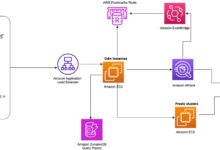AWS Cloud: 7 Powerful Reasons to Dominate the Future
Welcome to the world of AWS Cloud, where innovation meets scalability. Whether you’re a startup or a global enterprise, Amazon’s cloud platform offers unmatched flexibility, security, and performance to power your digital transformation.
What Is AWS Cloud and Why It Matters

Amazon Web Services (AWS) Cloud is the world’s most comprehensive and widely adopted cloud platform. Launched in 2006, AWS provides over 200 fully featured services from data centers globally, serving millions of customers—including startups, enterprises, and public sector organizations.
The Evolution of AWS Cloud
AWS began as a solution to streamline Amazon’s internal infrastructure but quickly evolved into a public cloud service. It launched with three core services: Simple Storage Service (S3), Elastic Compute Cloud (EC2), and Simple Queue Service (SQS). Today, AWS Cloud powers everything from small websites to complex AI-driven applications.
- 2006: AWS launches EC2, S3, and SQS
- 2010: Introduction of AWS Management Console
- 2014: AWS reaches 1 million active customers
- 2020: AWS hits $45 billion in annual revenue
According to AWS’s official site, the platform now serves customers in over 245 countries and territories.
Core Components of AWS Cloud
AWS Cloud is built on a foundation of compute, storage, and networking services. These components allow users to deploy applications, store data, and manage traffic efficiently.
- Compute: Services like EC2, Lambda, and ECS enable scalable processing power.
- Storage: S3, EBS, and Glacier offer durable, secure, and cost-effective storage solutions.
- Networking: VPC, Route 53, and CloudFront ensure fast, reliable, and secure connectivity.
“AWS is not just a cloud provider; it’s a platform for innovation.” — Andy Jassy, CEO of Amazon
Key Benefits of Using AWS Cloud
Organizations choose AWS Cloud for its reliability, scalability, and innovation. It enables businesses to launch faster, scale smarter, and reduce operational costs.
Unmatched Scalability and Flexibility
One of the biggest advantages of AWS Cloud is its ability to scale on demand. Whether you need to handle a sudden spike in traffic or expand globally, AWS allows you to adjust resources in real time.
- Auto Scaling groups automatically add or remove EC2 instances based on demand.
- Serverless computing with AWS Lambda eliminates the need to manage servers.
- Global infrastructure with 33 Availability Zones across 12 geographic regions.
For example, Netflix uses AWS Cloud to stream content to over 200 million users worldwide, scaling seamlessly during peak hours.
Cost Efficiency and Pay-as-You-Go Model
AWS Cloud operates on a pay-as-you-go pricing model, meaning you only pay for what you use. This eliminates the need for large upfront investments in hardware.
- No long-term contracts or upfront commitments.
- Reserved Instances offer up to 75% savings for predictable workloads.
- Savings Plans provide flexible pricing for steady usage.
According to a case study by AWS, Netflix saves millions annually by leveraging AWS’s scalable infrastructure instead of maintaining physical data centers.
AWS Cloud Security: A Comprehensive Approach
Security is a top priority for AWS. The platform offers a shared responsibility model, where AWS manages the security of the cloud, and customers manage security in the cloud.
Shared Responsibility Model Explained
In the AWS Cloud, security is a shared responsibility between AWS and the customer. AWS is responsible for protecting the infrastructure that runs all of the services offered in the AWS Cloud.
- AWS Responsibilities: Hardware, software, networking, and facilities.
- Customer Responsibilities: Data encryption, access controls, firewall configuration, and OS patching.
This model ensures that both parties play a role in maintaining a secure environment.
Built-in Security Services and Compliance
AWS provides a wide range of security tools and compliance certifications to help organizations meet regulatory requirements.
- AWS Identity and Access Management (IAM): Controls user access to AWS resources.
- AWS Shield: Protects against DDoS attacks.
- AWS WAF: Filters malicious web traffic.
- Compliance: AWS complies with standards like GDPR, HIPAA, SOC 1/2/3, and ISO 27001.
For more details, visit the AWS Security Center.
AWS Cloud Computing Services Overview
AWS offers a vast array of services across multiple categories, enabling businesses to build, deploy, and manage applications efficiently.
Compute Services: Powering Your Applications
AWS provides several compute options tailored to different use cases.
- Amazon EC2: Virtual servers in the cloud with customizable instance types.
- AWS Lambda: Run code without provisioning servers (serverless).
- Amazon ECS & EKS: Container management using Docker and Kubernetes.
These services allow developers to focus on code rather than infrastructure management.
Storage Services: Secure and Scalable Data Solutions
AWS Cloud offers durable, secure, and cost-effective storage options for every need.
- Amazon S3: Object storage for backups, media, and big data.
- Amazon EBS: Block storage for EC2 instances.
- Amazon Glacier: Low-cost archival storage for long-term retention.
S3 alone stores trillions of objects and supports features like versioning, lifecycle policies, and cross-region replication.
Database Services: From SQL to NoSQL
AWS supports a wide variety of database engines, both relational and non-relational.
- Amazon RDS: Managed relational databases (MySQL, PostgreSQL, Oracle, etc.).
- Amazon DynamoDB: Fully managed NoSQL database for high-performance applications.
- Amazon Aurora: MySQL and PostgreSQL-compatible database with 5x the throughput.
These services reduce administrative overhead and improve availability through automated backups and failover.
Networking and Content Delivery in AWS Cloud
Efficient networking is crucial for performance and reliability in the cloud. AWS provides robust tools to manage traffic, connectivity, and content delivery.
Amazon VPC: Isolated Cloud Networks
Amazon Virtual Private Cloud (VPC) allows you to launch AWS resources in a logically isolated virtual network.
- Define IP ranges, subnets, and route tables.
- Control inbound and outbound traffic using Security Groups and Network ACLs.
- Connect to on-premises data centers via AWS Direct Connect or VPN.
VPCs are essential for building secure, customizable network architectures in the AWS Cloud.
Amazon CloudFront: Global Content Delivery
Amazon CloudFront is a content delivery network (CDN) that securely delivers data, videos, and applications to users globally with low latency.
- Caches content at 400+ edge locations worldwide.
- Integrates with S3, EC2, and Lambda@Edge for dynamic content.
- Supports HTTPS, field-level encryption, and DDoS protection.
Companies like Airbnb use CloudFront to deliver personalized content quickly to users around the world.
Machine Learning and AI Services on AWS Cloud
AWS Cloud is a leader in democratizing access to artificial intelligence and machine learning technologies.
Amazon SageMaker: Build, Train, and Deploy ML Models
Amazon SageMaker is a fully managed service that enables developers and data scientists to build, train, and deploy machine learning models at scale.
- Integrated Jupyter notebooks for data exploration.
- Built-in algorithms and one-click training.
- Automatic model tuning and deployment pipelines.
SageMaker reduces the time to go from idea to production, making ML accessible even to non-experts.
Pre-Built AI Services for Developers
AWS offers pre-trained AI services that can be integrated into applications without requiring deep ML expertise.
- Amazon Rekognition: Image and video analysis (face detection, object recognition).
- Amazon Polly: Text-to-speech synthesis with natural-sounding voices.
- Amazon Transcribe: Speech-to-text conversion.
- Amazon Lex: Build chatbots and voice assistants (powers Alexa).
These services are used by companies like BMW to enhance customer experiences through voice-enabled interfaces.
DevOps and Automation Tools in AWS Cloud
AWS provides a robust suite of DevOps tools to streamline development, testing, and deployment processes.
AWS CodePipeline and CodeBuild
These services enable continuous integration and continuous delivery (CI/CD) pipelines.
- AWS CodePipeline: Automates release pipelines for fast and reliable updates.
- AWS CodeBuild: Compiles source code, runs tests, and produces software packages.
- Integrates with GitHub, Bitbucket, and AWS CodeCommit.
Teams can automate testing and deployment, reducing human error and accelerating time to market.
Infrastructure as Code with AWS CloudFormation
AWS CloudFormation allows you to model and provision AWS resources using code.
- Define infrastructure in JSON or YAML templates.
- Automate deployment of entire environments (VPCs, EC2, RDS, etc.).
- Enables version control, repeatability, and consistency.
This approach is critical for maintaining compliance and managing complex cloud architectures at scale.
Global Infrastructure and Availability Zones
AWS Cloud’s global footprint is one of its greatest strengths, ensuring high availability and disaster recovery capabilities.
Regions and Availability Zones Architecture
AWS divides its infrastructure into geographic regions and isolated data centers called Availability Zones (AZs).
- Each region consists of 3+ AZs, physically separated but connected via low-latency links.
- As of 2024, AWS has 33 AZs across 12 regions, with more planned.
- Customers can deploy applications across multiple AZs for fault tolerance.
This architecture ensures that even if one data center fails, applications remain available.
Edge Locations and Global Reach
In addition to regions and AZs, AWS operates hundreds of edge locations for content caching and latency reduction.
- 400+ edge locations support CloudFront and Route 53.
- Reduces latency for end users by serving content from the nearest location.
- Supports real-time applications like gaming and live streaming.
This global network makes AWS Cloud ideal for international businesses.
Migrating to AWS Cloud: Strategies and Best Practices
Migrating to the cloud can be complex, but AWS provides tools and frameworks to simplify the process.
The 6 Rs of Cloud Migration
AWS recommends the 6 Rs strategy for planning migrations:
- Rehost (Lift & Shift): Move applications without changes.
- Refactor: Modify apps to take advantage of cloud-native features.
- Revise: Update parts of the application (e.g., add auto-scaling).
- Rebuild: Re-architect using serverless or containers.
- Replace: Switch to SaaS solutions (e.g., move to Salesforce).
- Retire: Decommission unused or obsolete systems.
This framework helps organizations prioritize and plan their migration paths effectively.
AWS Migration Services and Tools
AWS offers several tools to support migration efforts:
- AWS Server Migration Service (SMS): Automates replication of on-premises VMs.
- AWS Database Migration Service (DMS): Migrate databases with minimal downtime.
- AWS Application Discovery Service: Identify and assess on-premises applications.
- CloudEndure Migration: Real-time replication for seamless cutover.
For guidance, refer to the AWS Migration Hub.
Monitoring and Management in AWS Cloud
Effective monitoring is essential for maintaining performance, security, and cost control in the cloud.
Amazon CloudWatch: Real-Time Monitoring
Amazon CloudWatch collects metrics, logs, and events from AWS resources and applications.
- Monitor CPU usage, disk I/O, request counts, and custom metrics.
- Set alarms to trigger notifications or auto-scaling actions.
- Visualize data with dashboards.
CloudWatch provides real-time visibility into system health and performance.
AWS Systems Manager: Operational Insights
AWS Systems Manager helps you automate operational tasks and gain insights into your environment.
- Run commands across thousands of EC2 instances simultaneously.
- Manage patches, configurations, and inventory.
- Track compliance and operational status.
It reduces manual effort and improves operational efficiency.
Cost Management and Optimization in AWS Cloud
While AWS offers cost savings, uncontrolled usage can lead to high bills. Proper cost management is crucial.
Using AWS Cost Explorer and Budgets
AWS provides tools to track, analyze, and optimize spending.
- AWS Cost Explorer: Visualize and forecast spending trends.
- AWS Budgets: Set custom cost and usage alerts.
- Cost and Usage Reports (CUR): Detailed breakdowns for analysis.
These tools help identify underutilized resources and optimize spending.
Best Practices for Cost Optimization
To get the most value from AWS Cloud, follow these best practices:
- Use Reserved Instances or Savings Plans for predictable workloads.
- Right-size EC2 instances based on actual usage.
- Delete unused EBS volumes and snapshots.
- Enable S3 lifecycle policies to move data to cheaper storage tiers.
- Leverage spot instances for fault-tolerant, flexible workloads.
Regular audits and tagging strategies also help maintain cost discipline.
Real-World Use Cases of AWS Cloud
AWS Cloud powers a wide range of industries and applications, from startups to government agencies.
Startups and Innovation
Startups use AWS Cloud to launch quickly and scale without heavy investment.
- Slack used AWS to scale rapidly during its early growth phase.
- Canva leverages AWS for real-time collaboration and image rendering.
- AWS Activate program provides credits, training, and support for startups.
The agility of AWS Cloud enables innovation at speed.
Enterprise and Government Adoption
Large organizations trust AWS for mission-critical workloads.
- Capital One migrated its entire IT infrastructure to AWS.
- The U.S. Department of Defense uses AWS for secure, scalable computing.
- BMW uses AWS for connected car services and AI-driven analytics.
These cases demonstrate AWS Cloud’s reliability and compliance capabilities.
What is AWS Cloud?
AWS Cloud is Amazon’s cloud computing platform that provides on-demand IT resources like servers, storage, databases, and machine learning over the internet, with a pay-as-you-go pricing model.
Is AWS Cloud secure?
Yes, AWS Cloud is highly secure, offering a shared responsibility model, built-in encryption, identity management, DDoS protection, and compliance with global standards like GDPR and HIPAA.
How much does AWS Cloud cost?
Costs vary based on usage. AWS offers a free tier for new users, and services are billed based on consumption. Tools like Cost Explorer help monitor and optimize spending.
Can I migrate my existing applications to AWS Cloud?
Yes, AWS provides migration tools and services like AWS DMS, SMS, and Migration Hub to help move applications, databases, and servers with minimal downtime.
What industries use AWS Cloud?
AWS is used across industries including tech, finance, healthcare, media, government, automotive, and education, supporting everything from web apps to AI and IoT.
In conclusion, AWS Cloud stands as a powerful, flexible, and secure foundation for modern digital transformation. From startups to global enterprises, its vast array of services, global infrastructure, and innovation in AI and DevOps make it the leading choice in cloud computing. By leveraging AWS, organizations can scale efficiently, reduce costs, and accelerate innovation in an increasingly competitive digital landscape.
Further Reading:









